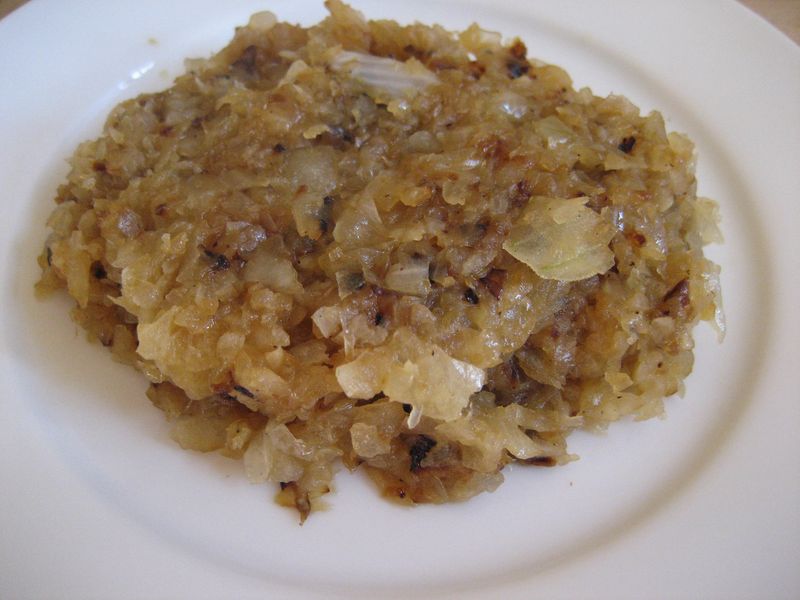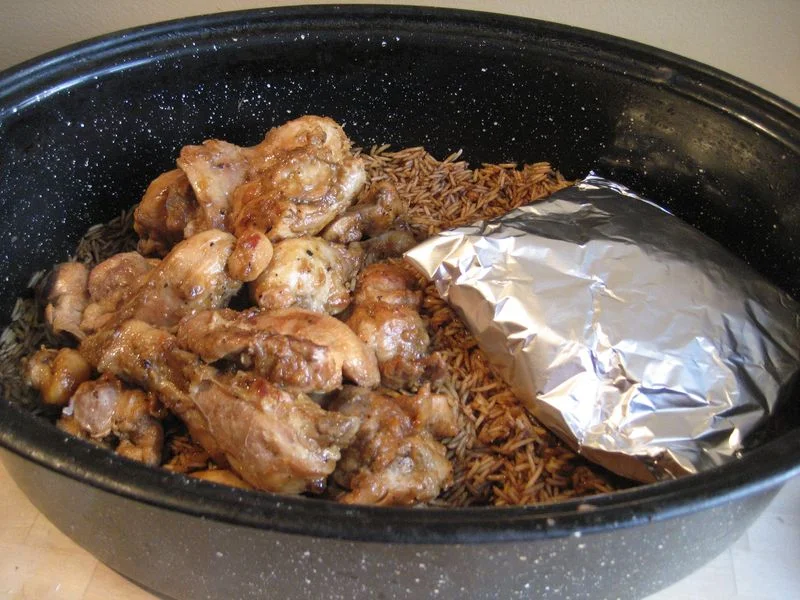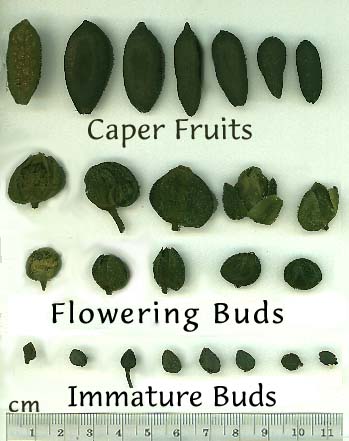A delicious plate of Qabili Palau
By Humaira
An Afghan woman's marriage prospects hinges on her ability to make Palau. So, you can imagine how much thought and effort goes into perfecting the Afghan rice dish. To this day my children and husband tell me that my Palau is not as good as my mom's. Thank goodness Jim didn't test my Palau making skills before he proposed to me over 17 years ago.
Jeja, my mom, makes the best Kabuli Palau in our family. My cousins request this dish when they visit her. Kabuli Palau was created by the upper class families of Kabul who could afford to include caramalized carrots, plump raisins and coveted nuts in their rice.
Over time as people in Afghanistan became wealthier this dish became more common. So, the name was changed from Kabuli Palau to Qabili Palau. The Dari word Qabil - means well accomplished, indicating that only a skilled chef can truely balance the various flavors of this dish.
The most important part of making Qabili Palaus is to keep the rice from breaking while it develops a deep rich brown color in the multi step cooking process. Most people think we use brown rice, let me tell you folks, I had not seen brown rice until I was well into my 20's when I started cooking for myself. The white, long grain rice takes on a rich brown color from the caramalized onions and chicken sauce.
Using unprocessed, long grain white rice is key in having success with this dish. I buy rice from the Afghan grocery market which passes muster with Jeja. I soak the rice in water for at least an hour to plump up the grains but most store bought Basmati rice can't handle the soaking and the two step cooking technique. That is why I left out the soaking in my recipe.
This dish takes me around 1:45 minutes from start to finish. I have integrated short cuts to help save time. I know Jeja would frown upon some of my techniques but I have made sure that the Palau retains the rich flavors of the original recipe.
I hope you too can make the best Kabuli/Qabili Palau from this this updated recipe.
IMG_6175
Uncooked raisins, carrots & almonds
Kabuli/Qabili Palau - Afghanistan’s National Dish
4 cups basmati rice
5 skinless chicken legs
5 skinless chicken thighs
3 medium yellow onions, peeled and quartered
½ c plus 2 tbsp. olive oil or vegetable oil, divided
5 tsp. salt
1 cup chicken broth
3 large carrots, peeled
1 cup black raisins
½ cup slivered almonds
3 tbsp. sugar
¾ cup water
2 tsp. ground cumin
1 ½ tsp. ground cardamom
½ tsp. ground black pepper
12 cups water
2 tbsp. browning sauce such at Kitchen Bouquet (optional)*
Instructions:
Preheat the oven to 500 degrees.
Immerse rice in a bowl of water and drain in a colander. Repeat this step 3 times.
Wash and dry the chicken. Set aside.
Chop the onions in a food processor using the pulse button. Don't puree the onions. You can do this by hand if you prefer.
Choose a sauté pan that is at least a couple inches deep and large enough to fit all the chicken. Pour ½ cup of the oil in the pan and sauté the onions over high heat, stirring quickly, until brown (5-10 minutes). Don't burn them.
IMG_6174
The onions take on a deep rich brown color
Add the chicken to the pan and sprinkle with 3 tsp. of the salt. Cook the chicken over medium-high heat for 6 minutes, turning from time to time so all sides turn golden brown. The onion will start to caramelize and turn into a thick sauce.
Add 1/4 cup of the chicken broth, and continue stirring to keep the chicken from burning. Once the liquid has been absorbed, add another 1/4 cup of chicken broth, bring it to a boil, cover with a lid or aluminum foil, and simmer for 10 minutes. The sauce should turn a dark brown. If your sauce does not take on a dark color you can add the Kitchen Bouquet to give it color.
While the chicken is cooking, cut the carrots into long think matchsticks, about 4 inches long and 1/8-inch thick. Make sure that they are not too thin. In a large frying pan add ¾ cups of water and bring to a boil, add the carrots and cook until tender and a deep orange hue, 5 to 7 minutes.
Keep a close eye on this to make sure you do not overcook them. Once the carrots are done, drain any leftover liquid out of the pan. Add the remaining 2 tbsp of oil, raisins, almonds and sugar to the carrots. Stir quickly over medium-high heat and keep stirring for about 3 minutes. The raisins will look plump; the carrots will take on a nice sweet flavor. Remove from heat and package the carrots into a sealed aluminum foil pouch about the size of a small paperback novel.
IMG_6183
Cooked carrot, raisins and almond in a pouch
Remove the chicken pieces from the broth and set aside. Stir the cumin, cardamom and black pepper into the broth. Continue to cook on low for 5 minutes to allow it to thicken.
Meanwhile, measure 12 cups of water and the remaining 2 tsp. of salt into a large Dutch oven or pot (see our Palau post for photos) with a fitted lid. Bring it to a boil. Add the rice to the water and boil until it is al dente (nearly cooked, though still slightly crunchy). This will take just a few minutes depending on the rice you use. You will have to taste it to check for doneness. Do not overcook it.
Immediately strain the rice through a colander. Put the rice back into the cooking pot and add the sauce from the chicken. Mix well. Arrange the chicken pieces on top of the rice. Set the aluminum package of carrots on top of the rice. This will keep the carrots warm and deepen the flavors without mixing with the rice yet.
IMG_6185
Qabili Palau pot ready to go into the oven
Bake the rice for 15 minutes in 500 degrees then drop the temperature down to 250 degrees. Cook for another 20 minutes.
Arrange the chicken pieces on a large platter, cover with the rice. Sprinkle the carrots, raisins, and almonds on the rice. Serve with a simple salata.
Serves 6-8
Except where otherwise noted, all content on this blog is licensed under the Creative Commons Attribution-NonCommercial-NoDerivs 3.0 Unported license.











